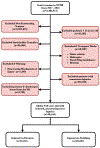The effect of transport mode on mortality following isolated penetrating torso Trauma
- PMID: 37453802
- PMCID: PMC10528673
- DOI: 10.1016/j.amjsurg.2023.06.033
The effect of transport mode on mortality following isolated penetrating torso Trauma
Abstract
Background: Prehospital interventions may increase the time to definitive care. Compared to ground ambulance, we hypothesize improved mortality for patients with isolated, penetrating torso injuries transported via private vehicle.
Methods: We reviewed the National Trauma Data Bank (2017-2021) for adults with isolated, penetrating torso injuries stratified by mechanism (stabbing vs. firearm) and transport mode (private vehicle vs. ground ambulance). We performed a multivariable logistic regression to estimate the effect of transport mode on mortality.
Results: 48,444 patients met our inclusion criteria. Patients transported by ambulance, injured by stabbing (n = 26,633) and by firearm (n = 21,811) had adjusted odds ratios of 1.81 (95%CI 1.05-3.14, p = 0.03) and 1.66 (95%CI 1.32-2.09,p < 0.001) respectively for mortality compared to private vehicle transport.
Conclusion: Patients with penetrating torso injuries have nearly twice the odds of mortality when transported by ground ambulance than private vehicles, despite injury severity. The "scoop and run" strategy may confer a survival benefit in this population.
Keywords: Emergency medical services and trauma; Ground ambulance transport; Penetrating torso trauma; Private vehicle transport.
Copyright © 2023 Elsevier Inc. All rights reserved.
Conflict of interest statement
Declaration of competing interest The authors whose names are listed immediately below certify that they have NO affiliations with or involvement in any organization or entity with any financial interest (such as honoraria; educational grants; participation in speakers’ bureaus; membership, employment, consultancies, stock ownership, or other equity interest; and expert testimony or patent-licensing arrangements), or non-financial interest (such as personal or professional relationships, affiliations, knowledge or beliefs) in the subject matter or materials discussed in this manuscript.
Figures
Similar articles
-
Association of Prehospital Mode of Transport With Mortality in Penetrating Trauma: A Trauma System-Level Assessment of Private Vehicle Transportation vs Ground Emergency Medical Services.JAMA Surg. 2018 Feb 1;153(2):107-113. doi: 10.1001/jamasurg.2017.3601. JAMA Surg. 2018. PMID: 28975247 Free PMC article.
-
The Impact of Prehospital Transport Mode on Mortality of Penetrating Trauma Patients.Air Med J. 2020 Nov-Dec;39(6):502-505. doi: 10.1016/j.amj.2020.07.005. Epub 2020 Aug 11. Air Med J. 2020. PMID: 33228903
-
An Eastern Association for the Surgery of Trauma multicenter trial examining prehospital procedures in penetrating trauma patients.J Trauma Acute Care Surg. 2021 Jul 1;91(1):130-140. doi: 10.1097/TA.0000000000003151. J Trauma Acute Care Surg. 2021. PMID: 33675330 Free PMC article.
-
Increased mortality associated with EMS transport of gunshot wound victims when compared to private vehicle transport.Injury. 2014 Sep;45(9):1320-6. doi: 10.1016/j.injury.2014.05.032. Epub 2014 Jun 5. Injury. 2014. PMID: 24957424
-
The prehospital management of ambulance-attended adults who fell: A scoping review.Australas Emerg Care. 2023 Mar;26(1):45-53. doi: 10.1016/j.auec.2022.07.006. Epub 2022 Jul 29. Australas Emerg Care. 2023. PMID: 35909044
Cited by
-
Predicting Factors Associated with In-hospital Mortality in Traumatic Brain Injury.Asian J Neurosurg. 2025 Mar 25;20(2):229-235. doi: 10.1055/s-0044-1793930. eCollection 2025 Jun. Asian J Neurosurg. 2025. PMID: 40485790 Free PMC article.
References
Publication types
MeSH terms
Grants and funding
LinkOut - more resources
Full Text Sources
Medical
Miscellaneous



